Page 36 of 207

Downloaded from www.Manualslib.com manuals search engine 2-21BEFORE DRIVING
60MK0-14E
65D606 65D201 65D199
WARNING
Never allow persons to ride in the
cargo area of a vehicle. In the event
of an accident, there is a much
greater risk of injury for persons
who are not riding in a seat with
their seat belt securely fastened.
Seat belts should always be
adjusted as follows:
– the lap portion of the belt should
be worn low across the pelvis,
not across the waist.
– the shoulder straps should be
worn on the outside shoulder
only, and never under the arm.
– the shoulder straps should be
away from your face and neck,
but not falling off your shoulder.
(Continued)
Above the pelvis
WARNING
(Continued)
Seat belts should never be worn
with the straps twisted and should
be adjusted as tightly as is com-
fortable to provide the protection
for which they have been designed.
A slack belt will provide less pro-
tection than one which is snug.
Make sure that each seat belt
buckle is inserted into the proper
buckle catch. It is possible to cross
the buckles in the rear seat.
(Continued)
Across the pelvis
WARNING
(Continued)
Pregnant women should use seat
belts, although specific recommen-
dations about driving should be
made by the woman’s medical advi-
sor. Remember that the lap portion
of the belt should be worn as low
as possible across the hips, as
shown in the diagram.
Do not wear your seat belt over
hard or breakable objects in your
pockets or on your clothing. If an
accident occurs, objects such as
glasses, pens, etc. under the seat
belt can cause injury.
(Continued)
as low as possible
across the hips
Page 37 of 207
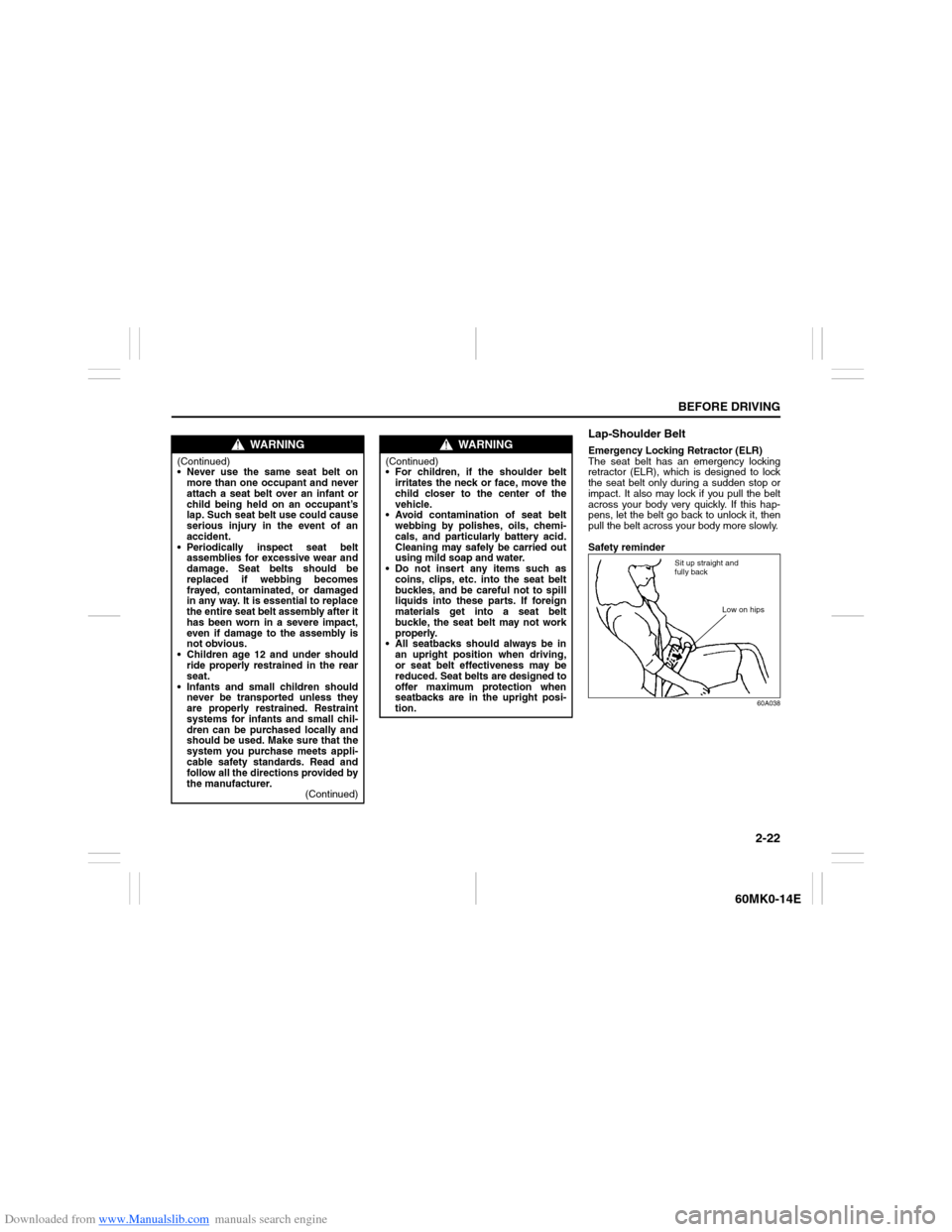
Downloaded from www.Manualslib.com manuals search engine 2-22
BEFORE DRIVING
60MK0-14E
Lap-Shoulder BeltEmergency Locking Retractor (ELR)
The seat belt has an emergency locking
retractor (ELR), which is designed to lock
the seat belt only during a sudden stop or
impact. It also may lock if you pull the belt
across your body very quickly. If this hap-
pens, let the belt go back to unlock it, then
pull the belt across your body more slowly.
Safety reminder
60A038
WARNING
(Continued)
Never use the same seat belt on
more than one occupant and never
attach a seat belt over an infant or
child being held on an occupant’s
lap. Such seat belt use could cause
serious injury in the event of an
accident.
Periodically inspect seat belt
assemblies for excessive wear and
damage. Seat belts should be
replaced if webbing becomes
frayed, contaminated, or damaged
in any way. It is essential to replace
the entire seat belt assembly after it
has been worn in a severe impact,
even if damage to the assembly is
not obvious.
Children age 12 and under should
ride properly restrained in the rear
seat.
Infants and small children should
never be transported unless they
are properly restrained. Restraint
systems for infants and small chil-
dren can be purchased locally and
should be used. Make sure that the
system you purchase meets appli-
cable safety standards. Read and
follow all the directions provided by
the manufacturer.
(Continued)
WARNING
(Continued)
For children, if the shoulder belt
irritates the neck or face, move the
child closer to the center of the
vehicle.
Avoid contamination of seat belt
webbing by polishes, oils, chemi-
cals, and particularly battery acid.
Cleaning may safely be carried out
using mild soap and water.
Do not insert any items such as
coins, clips, etc. into the seat belt
buckles, and be careful not to spill
liquids into these parts. If foreign
materials get into a seat belt
buckle, the seat belt may not work
properly.
All seatbacks should always be in
an upright position when driving,
or seat belt effectiveness may be
reduced. Seat belts are designed to
offer maximum protection when
seatbacks are in the upright posi-
tion.
Sit up straight and
fully back
Low on hips
Page 39 of 207
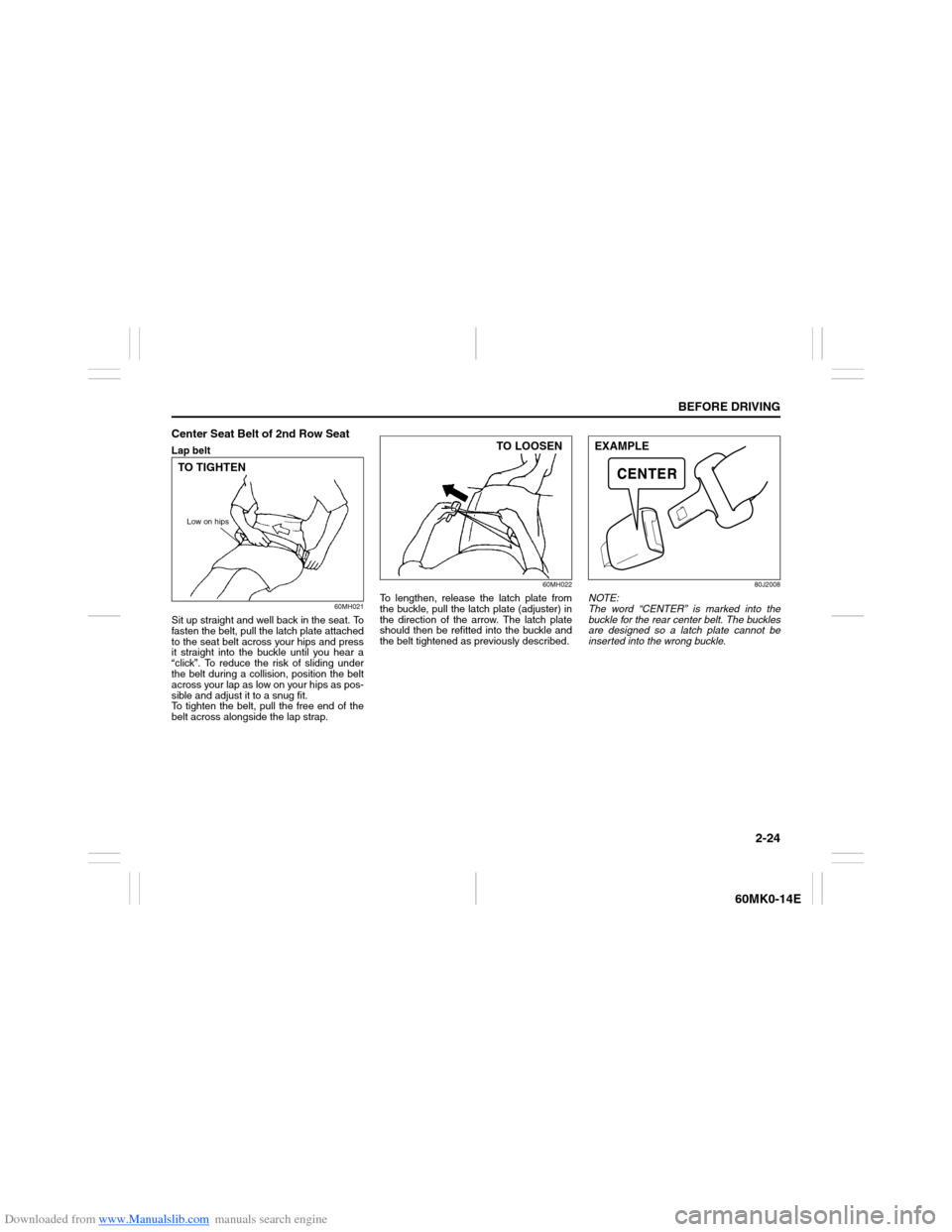
Downloaded from www.Manualslib.com manuals search engine 2-24
BEFORE DRIVING
60MK0-14E
Center Seat Belt of 2nd Row SeatLap belt
60MH021
Sit up straight and well back in the seat. To
fasten the belt, pull the latch plate attached
to the seat belt across your hips and press
it straight into the buckle until you hear a
“click”. To reduce the risk of sliding under
the belt during a collision, position the belt
across your lap as low on your hips as pos-
sible and adjust it to a snug fit.
To tighten the belt, pull the free end of the
belt across alongside the lap strap.
60MH022
To lengthen, release the latch plate from
the buckle, pull the latch plate (adjuster) in
the direction of the arrow. The latch plate
should then be refitted into the buckle and
the belt tightened as previously described.
80J2008
NOTE:
The word “CENTER” is marked into the
buckle for the rear center belt. The buckles
are designed so a latch plate cannot be
inserted into the wrong buckle.
TO TIGHTENLow on hips
TO LOOSEN
EXAMPLE
Page 42 of 207
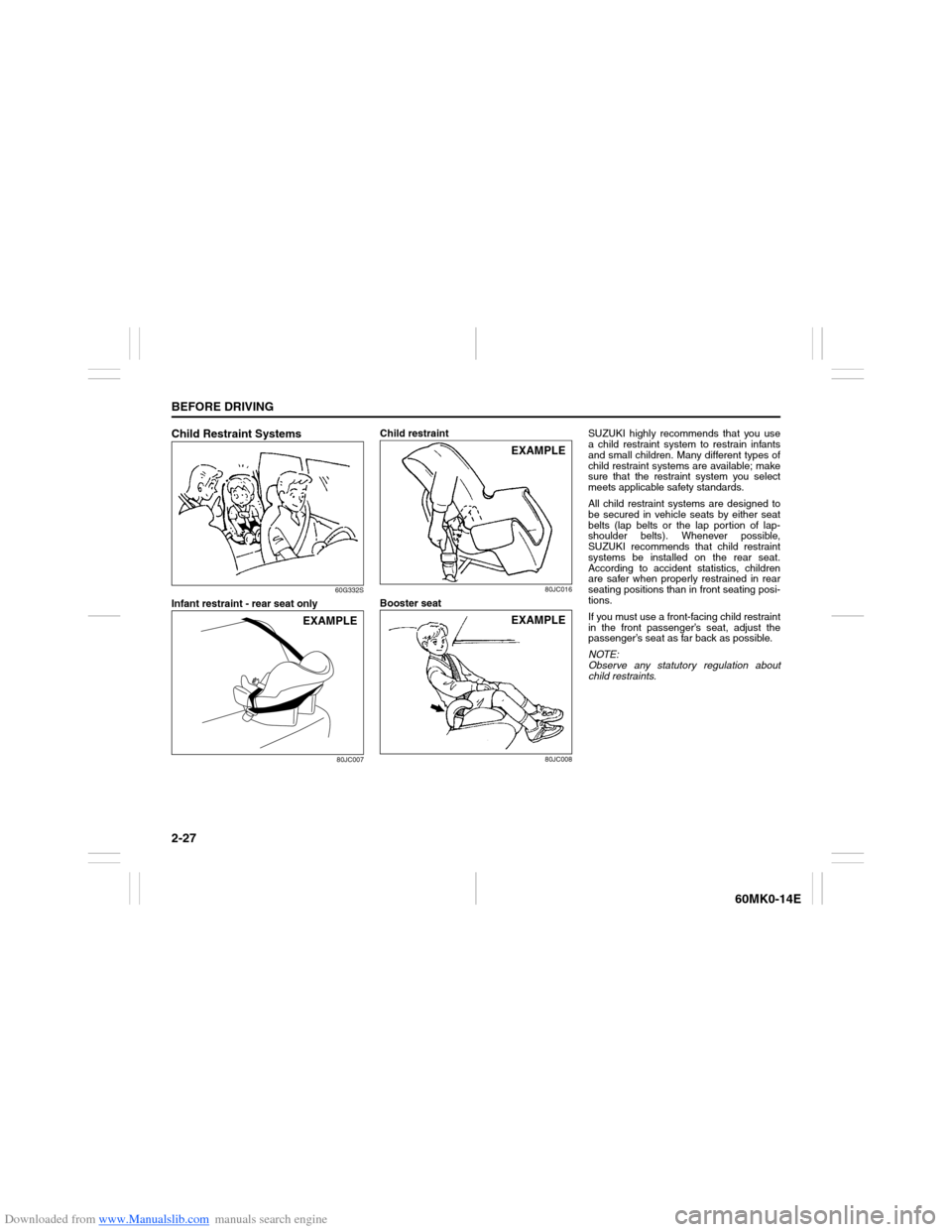
Downloaded from www.Manualslib.com manuals search engine 2-27BEFORE DRIVING
60MK0-14E
Child Restraint Systems
60G332S
Infant restraint - rear seat only
80JC007
Child restraint
80JC016
Booster seat
80JC008
SUZUKI highly recommends that you use
a child restraint system to restrain infants
and small children. Many different types of
child restraint systems are available; make
sure that the restraint system you select
meets applicable safety standards.
All child restraint systems are designed to
be secured in vehicle seats by either seat
belts (lap belts or the lap portion of lap-
shoulder belts). Whenever possible,
SUZUKI recommends that child restraint
systems be installed on the rear seat.
According to accident statistics, children
are safer when properly restrained in rear
seating positions than in front seating posi-
tions.
If you must use a front-facing child restraint
in the front passenger’s seat, adjust the
passenger’s seat as far back as possible.
NOTE:
Observe any statutory regulation about
child restraints.
EXAMPLE
EXAMPLEEXAMPLE
Page 43 of 207
Downloaded from www.Manualslib.com manuals search engine 2-28
BEFORE DRIVING
60MK0-14E
58MS03065D608
65D609
WARNING
If your vehicle is equipped with a
front passenger air bag, do not install
a rear-facing child restraint in the
front passenger’s seat. If the passen-
ger’s air bag inflates, a child in a rear-
facing child restraint could be killed
or seriously injured. The back of a
rear-facing child restraint would be
too close to the inflating air bag.
WARNING
If you install a child restraint system
in the 2nd row seat, slide the seat
installed the child restraint system as
far back as possible. If you install a
child restraint system in the 3rd row
seat, slide the seat in front of the seat
installed a child restraint system
enough forward so that the child’s
feet do not contact the front seat-
back. These will help avoid injury to
the child in the event of an accident.
Page 44 of 207
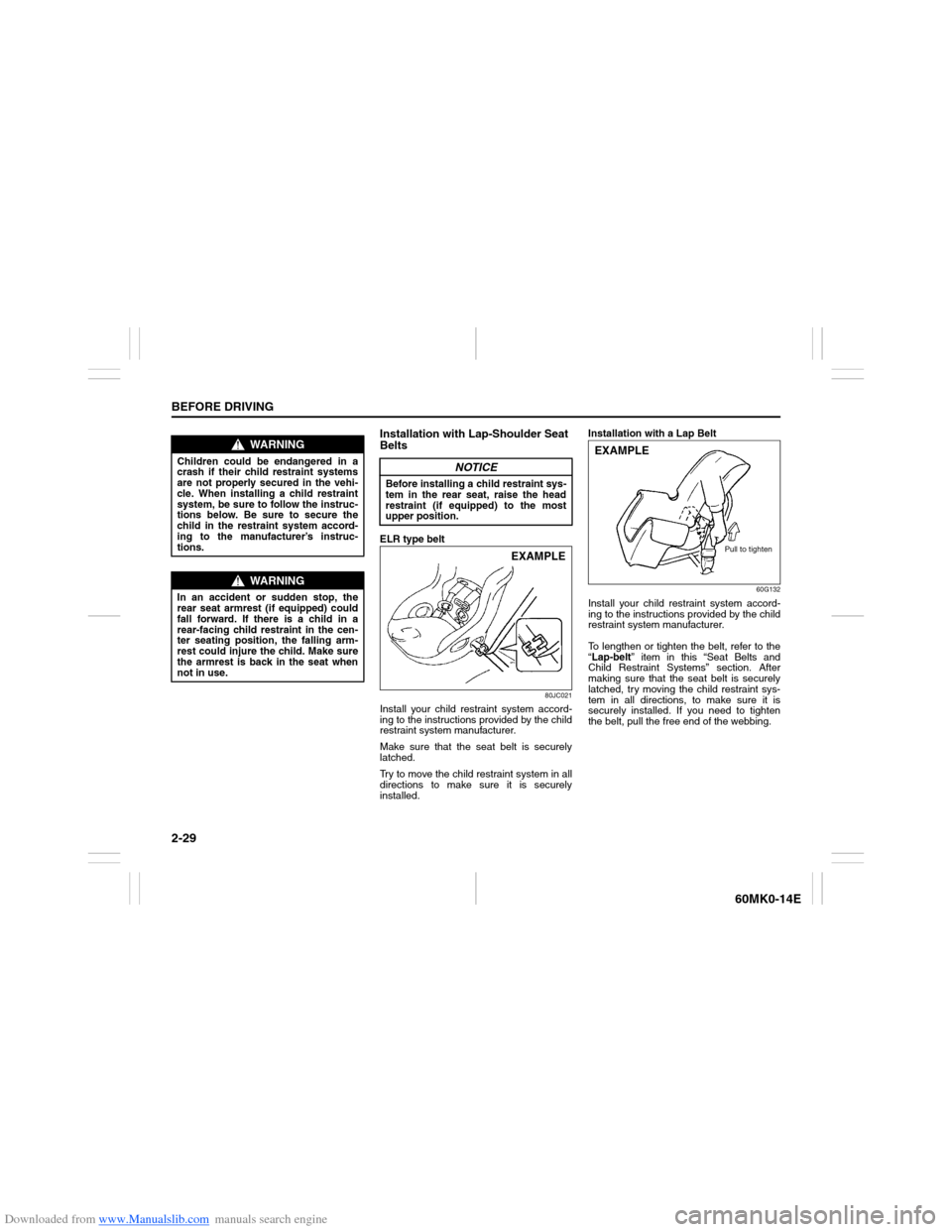
Downloaded from www.Manualslib.com manuals search engine 2-29BEFORE DRIVING
60MK0-14E
Installation with Lap-Shoulder Seat
BeltsELR type belt
80JC021
Install your child restraint system accord-
ing to the instructions provided by the child
restraint system manufacturer.
Make sure that the seat belt is securely
latched.
Try to move the child restraint system in all
directions to make sure it is securely
installed.Installation with a Lap Belt
60G132
Install your child restraint system accord-
ing to the instructions provided by the child
restraint system manufacturer.
To lengthen or tighten the belt, refer to the
“Lap-belt” item in this “Seat Belts and
Child Restraint Systems” section. After
making sure that the seat belt is securely
latched, try moving the child restraint sys-
tem in all directions, to make sure it is
securely installed. If you need to tighten
the belt, pull the free end of the webbing.
WARNING
Children could be endangered in a
crash if their child restraint systems
are not properly secured in the vehi-
cle. When installing a child restraint
system, be sure to follow the instruc-
tions below. Be sure to secure the
child in the restraint system accord-
ing to the manufacturer’s instruc-
tions.
WARNING
In an accident or sudden stop, the
rear seat armrest (if equipped) could
fall forward. If there is a child in a
rear-facing child restraint in the cen-
ter seating position, the falling arm-
rest could injure the child. Make sure
the armrest is back in the seat when
not in use.
NOTICE
Before installing a child restraint sys-
tem in the rear seat, raise the head
restraint (if equipped) to the most
upper position.
EXAMPLE
EXAMPLE
Pull to tighten
Page 47 of 207
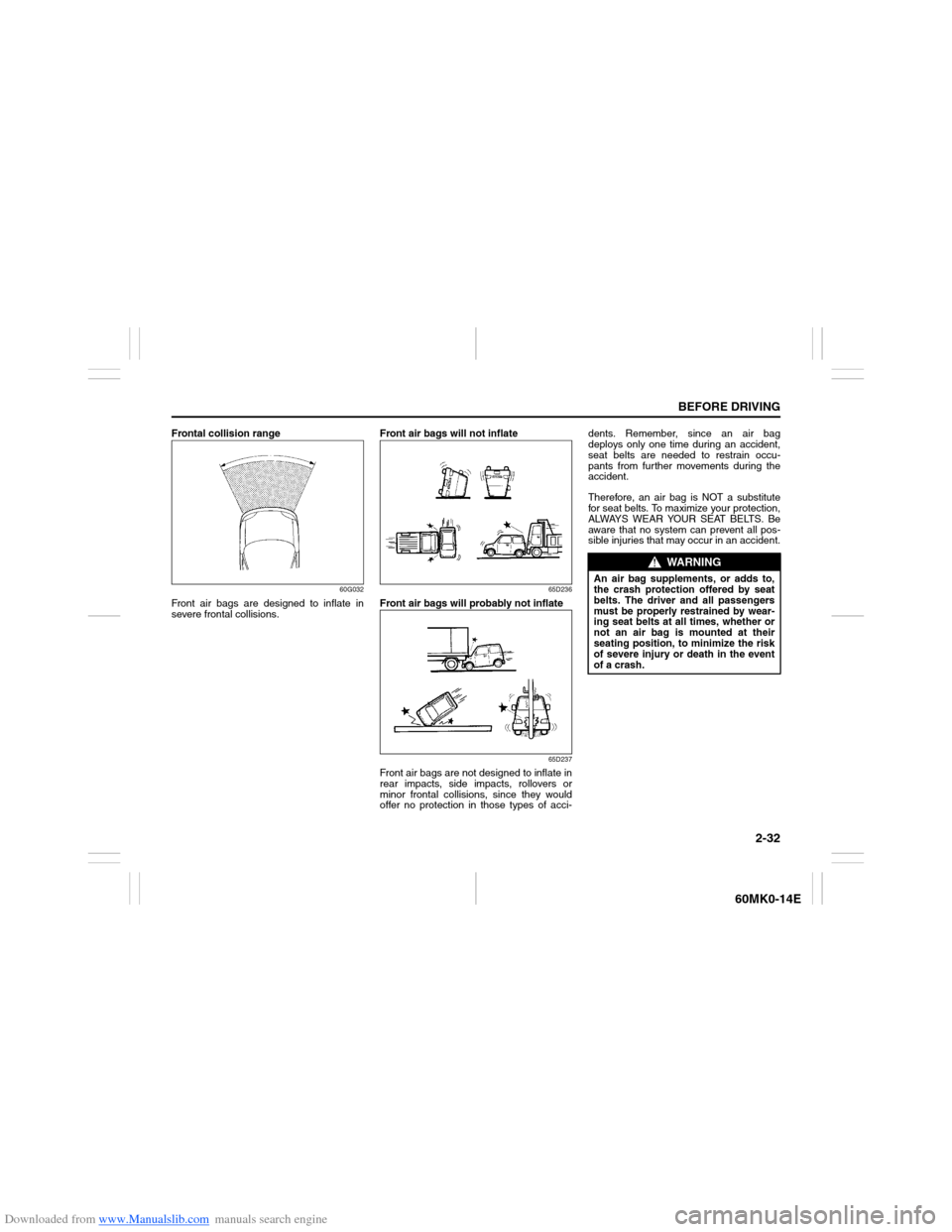
Downloaded from www.Manualslib.com manuals search engine 2-32
BEFORE DRIVING
60MK0-14E
Frontal collision range
60G032
Front air bags are designed to inflate in
severe frontal collisions.Front air bags will not inflate
65D236
Front air bags will probably not inflate
65D237
Front air bags are not designed to inflate in
rear impacts, side impacts, rollovers or
minor frontal collisions, since they would
offer no protection in those types of acci-dents. Remember, since an air bag
deploys only one time during an accident,
seat belts are needed to restrain occu-
pants from further movements during the
accident.
Therefore, an air bag is NOT a substitute
for seat belts. To maximize your protection,
ALWAYS WEAR YOUR SEAT BELTS. Be
aware that no system can prevent all pos-
sible injuries that may occur in an accident.
WARNING
An air bag supplements, or adds to,
the crash protection offered by seat
belts. The driver and all passengers
must be properly restrained by wear-
ing seat belts at all times, whether or
not an air bag is mounted at their
seating position, to minimize the risk
of severe injury or death in the event
of a crash.
Page 48 of 207
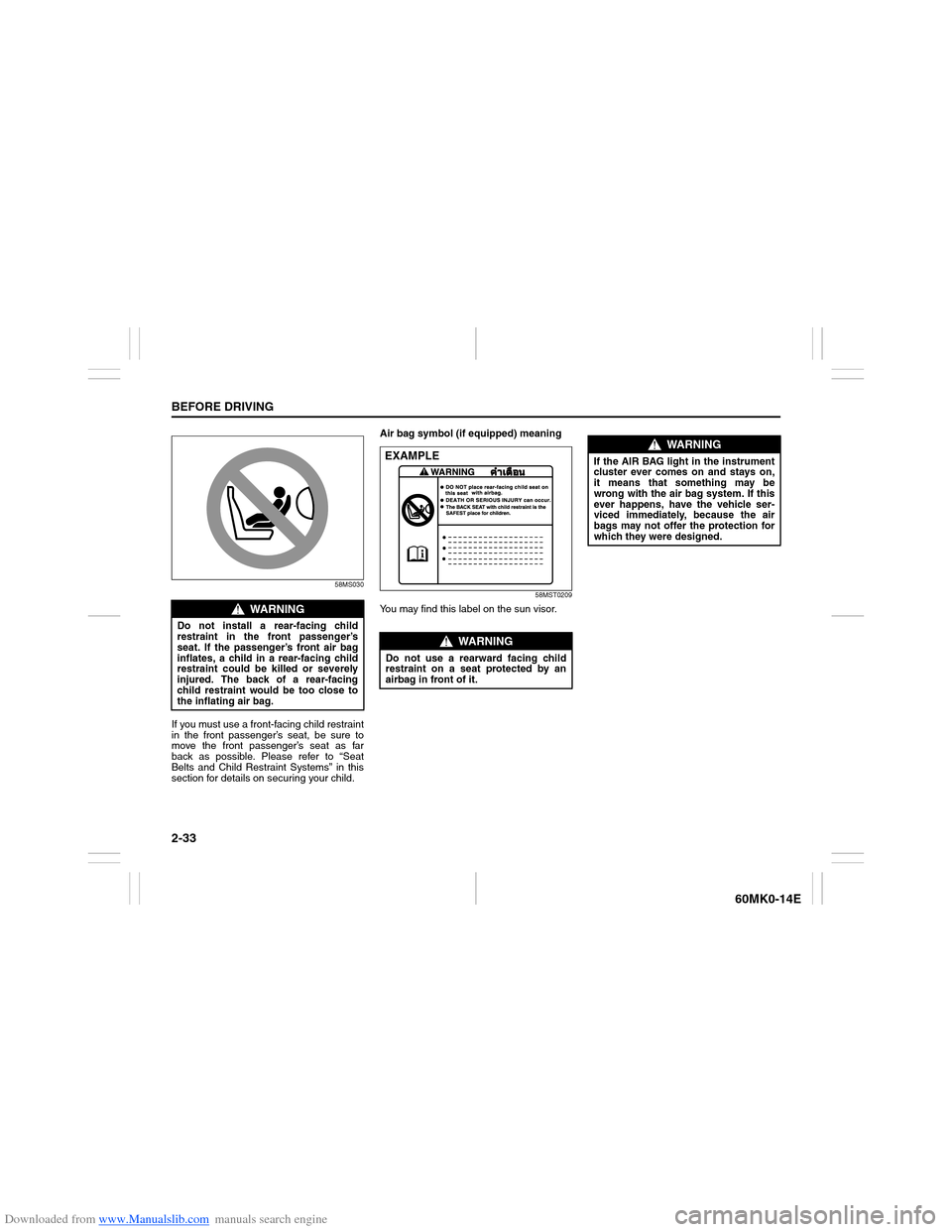
Downloaded from www.Manualslib.com manuals search engine 2-33BEFORE DRIVING
60MK0-14E
58MS030
If you must use a front-facing child restraint
in the front passenger’s seat, be sure to
move the front passenger’s seat as far
back as possible. Please refer to “Seat
Belts and Child Restraint Systems” in this
section for details on securing your child.Air bag symbol (if equipped) meaning
58MST0209
You may find this label on the sun visor.
WARNING
Do not install a rear-facing child
restraint in the front passenger’s
seat. If the passenger’s front air bag
inflates, a child in a rear-facing child
restraint could be killed or severely
injured. The back of a rear-facing
child restraint would be too close to
the inflating air bag.
WARNING
Do not use a rearward facing child
restraint on a seat protected by an
airbag in front of it.EXAMPLE
WARNING
If the AIR BAG light in the instrument
cluster ever comes on and stays on,
it means that something may be
wrong with the air bag system. If this
ever happens, have the vehicle ser-
viced immediately, because the air
bags may not offer the protection for
which they were designed.